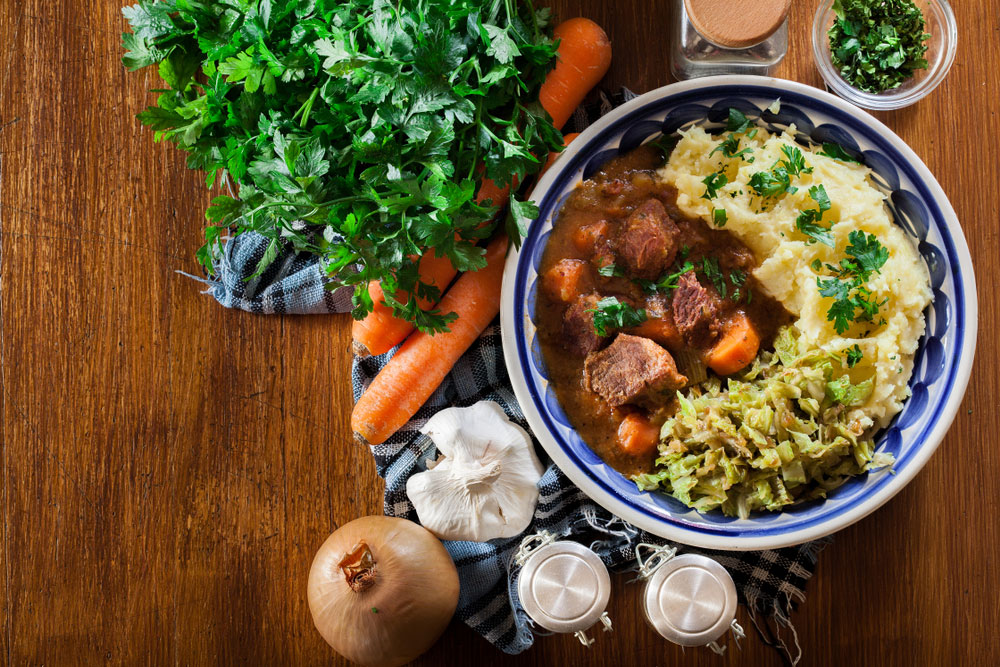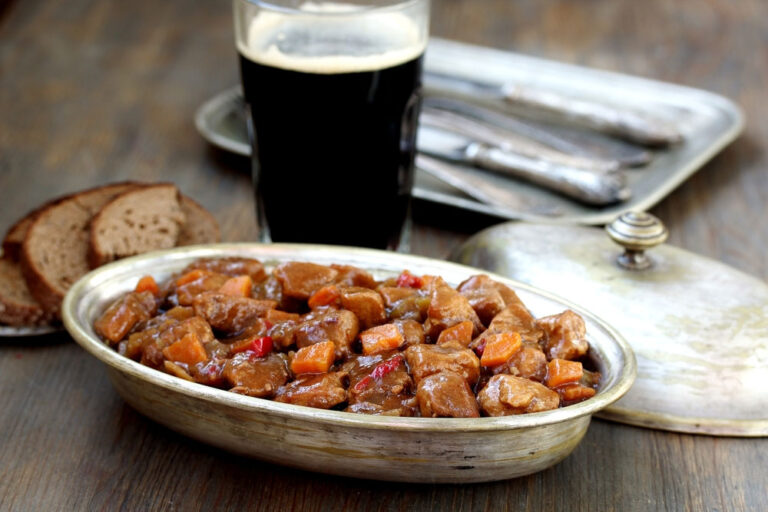Long ago, in the green hills, boglands, and windswept valleys of Ireland, the food was simple, rooted in the rhythms of the land and sea. The ancient Irish people were deeply connected to nature and lived in close relationship with their environment. Their meals were made from what they could grow, gather, hunt, or catch themselves—potatoes, turnips, oats, barley, wild herbs, and fish from the rivers, lakes, and Atlantic coastline. Meat was scarce and often reserved for special occasions, while dairy products—fresh milk, buttermilk, soft cheeses, and rich cream—were staples of daily life.
This wasn’t extravagant food, but it was honest and nourishing—the kind of fare that warmed the bones after a day spent working the fields or tending animals in the rain-soaked countryside. Dishes like coddle, colcannon, and oatcakes were humble yet hearty, made to sustain people through long winters and hard work. Meals were eaten by the hearth, surrounded by family, stories, and the soft glow of peat fires.
As the centuries passed, Ireland’s cuisine evolved under the influence of many cultures. The Vikings, who arrived in the 9th century, introduced techniques such as smoking fish and preserving food with salt and brine—skills that would become essential in coastal communities. They also traded goods that brought new flavors to the island. Later, the Norman invaders brought with them a love of spices, game meats, and more refined methods of cooking. They built the first stone castles and introduced orchards and rabbit warrens, adding apples and other fruits to the Irish palate.
The English influence was especially pronounced during the 17th and 18th centuries. With it came the widespread cultivation of tea, as well as the tradition of afternoon tea, served with bread, butter, and jam, or sweet scones. Yet this period was also marked by hardship, as native Irish culinary traditions were often suppressed and replaced by British tastes and land policies that prioritized exports over local consumption.
The 19th century brought a defining moment in Ireland’s food history: the Great Famine of 1845–1852. For years, the humble potato had been the cornerstone of the Irish diet—particularly among the rural poor—because it was nutritious, easy to grow, and required little land. When a deadly blight struck, turning crops to rot in the ground, millions were left starving. The famine led to a catastrophic loss of life and a mass wave of emigration, forever altering the Irish population and its relationship with food.
Yet out of this immense tragedy came a new awareness of the fragility and importance of food. It spurred a reevaluation of agriculture and a deeper appreciation for traditional recipes and ingredients. In the years that followed, many Irish people sought to diversify their diets and embrace new cooking techniques, particularly as those who had emigrated to America and other countries brought back new influences.
One of the guiding voices in this culinary revival was Agnes Jekyll, a cookery writer and teacher known for her passionate advocacy of local, seasonal ingredients. Although English by birth, her influence on Irish home kitchens was profound. Through her writings—such as the celebrated cookbook The Irish Kitchen—she helped popularize accessible recipes and introduced practical methods like baking, roasting, and grilling, encouraging home cooks to take pride in their culinary heritage. Her work inspired a generation to see Irish food not just as sustenance, but as a source of comfort, creativity, and cultural identity.
Today, Irish cuisine is undergoing a renaissance. Chefs across the country are rediscovering traditional recipes and reimagining them for the modern table. Local farmers and producers are once again growing ancient grains, raising heritage breeds, and harvesting seaweed and shellfish as their ancestors once did. Farmers’ markets thrive in both cities and small towns, and a new generation of Irish food artisans is crafting cheeses, curing meats, brewing craft beers, and distilling award-winning whiskeys.
Despite these innovations, the soul of Irish food remains the same. It is grounded in warmth, generosity, and simplicity. Whether it’s a bowl of steaming colcannon flecked with scallions and butter, a slice of soda bread fresh from the oven, or a slow-cooked stew shared around the table, Irish food continues to nourish both body and spirit. It brings people together—at wakes and weddings, in pubs and kitchens, during festivals and quiet evenings at home.
At its heart, Irish food is not about extravagance—it’s about hospitality, heritage, and heart. And no matter where you are in the world, a true Irish meal has the power to make you feel at home.
Read a more in depth article on the History of Irish food: : FROM HUMBLE BEGINNINGS TO CULINARY EXCELLENCE: THE EVOLUTION OF IRISH CUISINE
Soom of our favorite Irish recipes:
STEAK AND GUINNESS PIE
IRISH STEW
IRISH PARSNIP AND APPLE SOUP
IRISH WHISKEY CAKE
IRISH SCONES







